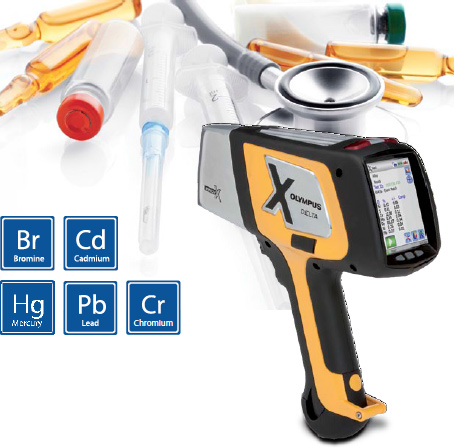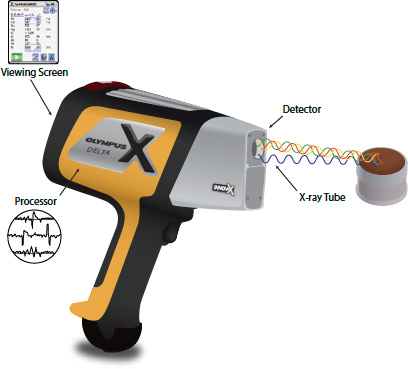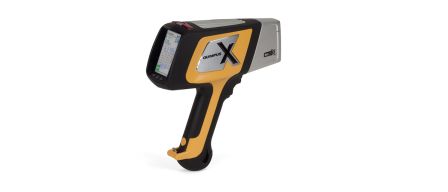This article describes handheld X-ray Fluorescence as a solution for RoHS compliance. The European Union (EU) Restriction on Hazardous Substances (RoHS) Directive regulates the use of cadmium (Cd), lead (Pb), mercury (Hg), hex-chromium (Cr6+), and two bromine (Br) compounds (PBB and PBDE) in consumer products.
The medical device industry was excluded from the RoHS Directive until the July, 2011 recast publication. Now the medical device industry has less than one year to meet the July, 2014 deadline for compliance, throughout its supply chain.
The Challenge
A recall due to RoHS noncompliance could have a tremendous and long-term detrimental impact on a brand’s reputation. As manufacturers spend months, if not years, developing a new product, with expectations of a long and profitable selling cycle, it is critical to take steps to comply with the RoHS Directive, from the very beginning of the supply chain all the way through to the end.
Similar to other multifaceted industries, medical device manufacturers have a very complex supply chain, with multiple layers of suppliers providing hundreds or thousands of highly tailored parts. The RoHS Directive supply chain traceability requirements and the need to find compliant alternatives or replacements, compounds supply chain management challenges.
Therefore, medical device manufacturers need a simple and effective compliance solution that is acceptable to the EU RoHS Directive and will work throughout the supply chain.
The Solution
 Medical device manufacturers are fortunate because consumer electronics industry leaders collaborated in the form of the International Electrotechnical Commission (IEC) to develop global testing methods for determining the levels of regulated substances in a consistent manner for the RoHS-1 Directive, effective July 1, 2006. Their published International Standard IEC 62321 includes a nondestructive screening procedure using X-ray fluorescence (XRF) spectrometry. This procedure is also applicable to a medical device company for a compliance program with the RoHS-2 Directive scheduled for July 22, 2014.
Medical device manufacturers are fortunate because consumer electronics industry leaders collaborated in the form of the International Electrotechnical Commission (IEC) to develop global testing methods for determining the levels of regulated substances in a consistent manner for the RoHS-1 Directive, effective July 1, 2006. Their published International Standard IEC 62321 includes a nondestructive screening procedure using X-ray fluorescence (XRF) spectrometry. This procedure is also applicable to a medical device company for a compliance program with the RoHS-2 Directive scheduled for July 22, 2014.
Handheld XRF Screening
Handheld XRF screening of the regulated substances— lead (Pb), mercury (Hg), chromium (Cr), bromine (Br) and cadmium (Cd)—in electric and electronic equipment is simple, fast, and cost-effective, both for risk management programs and RoHS compliance. This straightforward screening solution is used by manufacturers, government regulators, and all levels of the supply chain. Medical device manufacturers can simply adopt the same handheld XRF screening protocols as part of their reasonable testing plan for due diligence towards RoHS-2 Directive compliance.
According to the RoHS Directive, electrical and electronic medical device equipment for import into the EU can not contain Pb, Hg, Cr6+, or certain Br-compounds (PBB and PBDE) at levels over 0.1%, or Cd at levels over 0.01%. Limits of detection (LODs) for handheld XRF analyzers vary; however, most are well within the range necessary for RoHS compliance screening. Some testing programs may require advanced handheld XRF configurations to bolster confidence in detecting action levels of Cd and Cr in some alloy materials, especially solders and steel.
Another valuable contribution from early developments of RoHS compliance testing methods includes a knowledge base of common components with a historical use of restricted substances. These components are screened by most manufacturers on a regular basis as a part of risk management.
Understanding Handheld XRF Results
To make screening easier and faster, Olympus has incorporated typical RoHS screening needs into the results display. This includes dealing with nonhomogenous materials, surface and substrate inspections, detailed concentration and/or action-level Pass/Fail indications, and results navigation. All of the results information, including an image of the sample spot, can be generated into a report format for comprehensive screening documentation.
Handheld XRF for Small Samples or Small Spots on a Sample
Olympus XRF analyzers are equipped with a small spot collimator that can focus in on areas as small as 3 mm in diameter. On-screen displays of the measured area can be archived to memory for use in subsequent test reports.
Regulatory Testing with Handheld XRF
 Handheld XRF analyzers can identify contaminant metals and elements with little to no sample preparation, providing fast and decisive results. They are used worldwide to help ensure safety and to help comply with global regulatory programs directed by the EPA, RoHS/WEEE EU member states’ enforcement bodies, the CPSC, the FDA, border patrol, and more.
Handheld XRF analyzers can identify contaminant metals and elements with little to no sample preparation, providing fast and decisive results. They are used worldwide to help ensure safety and to help comply with global regulatory programs directed by the EPA, RoHS/WEEE EU member states’ enforcement bodies, the CPSC, the FDA, border patrol, and more.
Medical devices incorporate computers, monitors, power supplies, mechanical parts, plastic components, cables, integrated circuits, and more. Handheld XRF provides a simple, fast, and cost-effective risk management tool to screen all of them for the regulated substances - lead (Pb), mercury (Hg), chromium (Cr), bromine (Br) and cadmium (Cd).
As in other industries, medical device manufacturers have long established relationships with a myriad of suppliers. An important lesson learned from the RoHS-1 compliance experience is to “trust, but verify”. This philosophy helps ensure that all stakeholders in the supply chain benefit from RoHS compliance programs whether for new or established products and suppliers.
Supply Chain Benefits from Handheld XRF Screening
- Identifies risky parts and untrustworthy suppliers.
- Eliminates potentially noncompliant products at the source.
- Saves money by only sending the questionable samples to the lab.
- Minimizes or avoids legal problems and heavy fines by identifying the risky sources at an early stage in production.
XRF Screening Technology
Energy dispersive X-ray fluorescence (EDXRF) is an elemental analysis technique. A miniature X-ray tube excites material at the atomic level with enough energy to expel inner orbital electrons of an element, such as Pb, Hg, Cr, Br and Cd, while a detector measures the signature energies released when the element’s outer orbital electrons change orbital levels to regain stability. The detected energies (keV) reveal which elements are present in a material. The intensities (counts/s) of the energies correlate to the elemental concentrations in the material.


